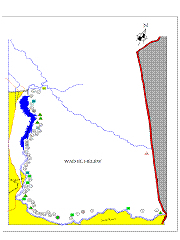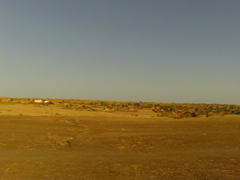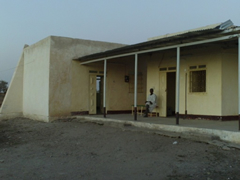- Home
- Technical Cooperation Projects
- Index of Countries
- Africa
- Sudan
- Capacity Development Project for Provision of the Services for Basic Human Needs in Kassala
- Project News
- Survey on Rural Health Facilities in Wad El Helew Locality (1)
Project News
2012-04-01
Survey on Rural Health Facilities in Wad El Helew Locality (1)
 Villages in Wad El Helew are located not far from the rivers
Villages in Wad El Helew are located not far from the rivers
As a part of the project activities in the health sector of K-TOP Project, JICA team conducted the situation analysis of rural health facilities in Wad El Helew (WEH) Locality and Girba Locality from October 2011 to February 2012. In this article, I would like to share with the readers about the general condition of these rural health facilities, which the villagers often refer to as "hospitals".
The population of WEH Locality is approximately 90,000, including the population of refugee camps. The Locality is shaped like a trapezoid slightly larger than a triangle. All the villages are located not far from the two rivers: the Setit running east-west in the southern boarder, and the Atbara running north-south in the western boarder.
In the eyes of a Japanese surveyor, villages are found scattered and far from each other. If you look far as you drive in the middle of the vast sorghum field or the dry sandy land, or driving on the road-like track with traces of vehicle tires, with stirring up the dust of the road, you will first see one or a few houses with the round thatched-roof. Gradually you see more houses, and you know that is a village. You will find one village in roughly every several kilometers. The average size of a village is 133 households and around 800 people. The houses are scattered in the expansion of the big land. As you get closer to the village, you may find one or two modern concrete-reinforced buildings. If the structure is small, that is usually a "hospital" you are looking for, but if the building is large or there are more than one building, it is usually a school.
 A look of a village
A look of a village
 A typical Basic Health Unit
A typical Basic Health Unit
A typical rural health facility looks deserted. Sometimes, even the door is locked. If you have given a notice before your visit, you will find a staff or two waiting for you. He (as we usually found male staff in a rural health facility, we refer the staff as "he") invites you to the consulting room, with a desk and a chair. On the desk is a register book of the outpatients. In the corner of the room is a partitioning curtain for the examination table. Some health facilities have a cabinet with a few boxes or bottles of medicine, disorderly placed in the dusty shelves.
(Reported by Ms. Atsuko Tsuruta, JICA Expert on Rural Health/Community Development)
- About JICA
- News & Features
- Countries & Regions
- Our Work
- Thematic Issues
- Types of Assistance
- Partnerships with Other Development Partners
- Climate Change / Environmental and Social Considerations
- Evaluations
- Compliance and Anti-corruption
- Science and Technology Cooperation on Global Issues
- Research
- JICA Development Studies Program / JICA Chair
- Support for the Acceptance of Foreign HRs / Multicultural and Inclusive Community
- Publications
- Investor Relations
